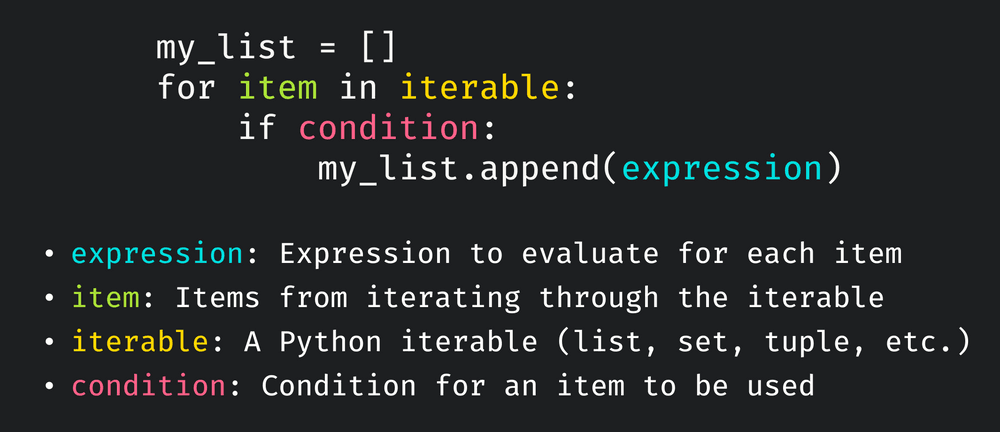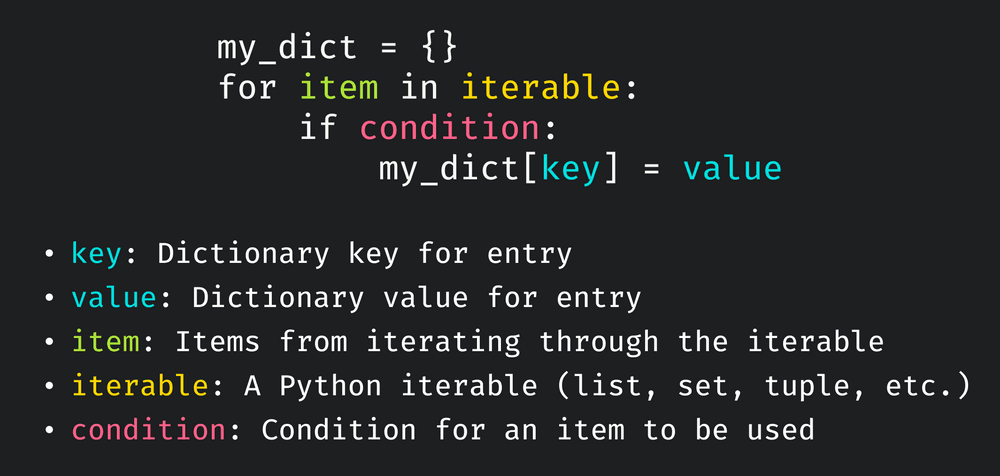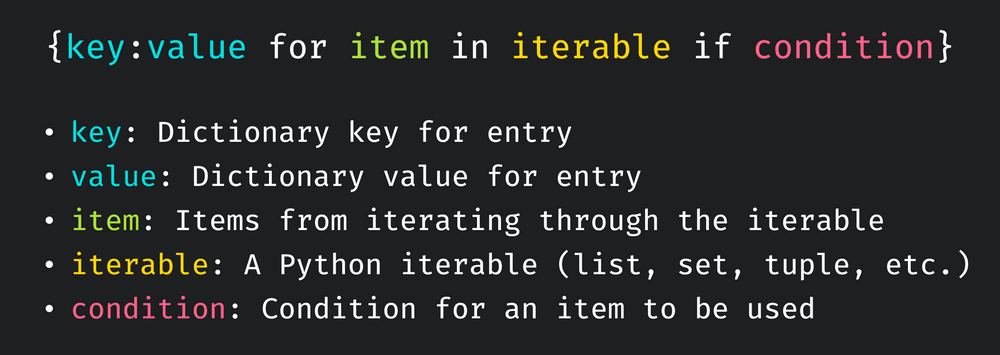The comprehension structure is one of the most iconic utilities in Python. Many of you may already be familiar with list comprehensions but did you know there are actually 4 types of comprehensions? In this post, we'll review list comprehensions and introduce the others that you may have not seen before. For each type I will present the iterative forms you may currently know and how you consider converting them into comprehensions.
Before we step into the material, let's consider why you'd want to use comprehensions in the first place. Generally speaking all types of comprehensions the benefits are as follows.
As I mentioned previously, list comprehensions are the most common and known comprehensions. To better understand how they work let's first look at how we can accomplish the same utility with a simple loop structure.
Consider how we might construct a basic list comprised of elements of a Python iterable when each item is passed through an expression. The general structure is something you may have already done before with a list initialization and a for loop to fill out the list based on the items passed into an expression.
A Python iterable is an object that returns its members one at a time. Some iterables that you may have already used are lists, sets, and tuples.
For smaller tasks, this structure is fine but as we add other bits of utility it can become harder to read the code while also adding additional overhead. Let's try to replicate this structure as a comprehension.
For a list comprehension, we wrap part of our prior for loop does code within brackets to produce a resultant list that is equivalent to the list from before.

The list comprehension handles the list initialization and appending needed before and reduces the code to just the important bits, what are we iterating over and what are we doing to each of the elements.
When iterating through a collection of items, we often only want to produce a list where the items pass a certain condition. We can extend the prior structure to have a condition quite easily. Let's start with extending the loop variant.

It's pretty simple to also extend this condition format into our comprehensions.

From now on I will just be including a condition in the structures of later iterations but they are always optional and depend on what you need!
One trend you may have noticed about comprehensions is that the part of the statement after the expression is just reading down each line of our iterative variant. Let's look closer at the case with a condition to see what I mean.
If you were to unravel the highlighted lines of the above code block and remove any additional formatting (:) then you would get what we wrote for our comprehension. This is a helpful way of thinking for taking iterative code that you're used to and writing it as comprehensions.
If you read other resources you might also see nested comprehensions where you can put a list comprehension into another list comprehension to generate a matrix or iterate over a matrix. To me, these kind of step away from the core principles of readability and simplicity that make comprehensions so great. I would recommend staying away from complicated comprehensions and rather expand that code for the sake of readability.
Let's look at some basic examples to see how we can write the tasks both as loops and comprehensions.
Let's assume we're given some iterable full of numbers (likely a set or list) and we want to produce a list of the squares of these numbers.
As you can see we get the exact same result! Let's go ahead and break down each of the important parts highlighted in the structure.
numbersnum ** 2Let's assume we're given a different iterable full of floating point numbers and we wish to use the function floor which rounds down to the nearest integer, but only if the numbers are positive.
As you can see, we can call functions or really execute any bit of code as the expression as we need! Often I will write a larger function and call that function from a simple comprehension.
Given a list of names, create a new list where every name is capitalized.
I hope at this point you have a decent grasp of how simple list comprehensions work. For later comprehensions we'll build off this so make sure this section makes sense!
You may not believe me, but you already grasp most of the information to understand generator comprehensions, even if they sound unfamiliar! Generator comprehensions are extremely similar to list comprehensions with some changes that can be very useful.
TLDR: Generators don't store all the results but just pass them one at a time when you call the generator. This is great for saving memory but not great if you want to save the resultant list.
I could write a whole blog post on just generators, but the important part to understand for this post is that generators are functions that you can write that act like iterators. Let's work through a simple example and see why generators are useful. Let's consider our prior example of squaring numbers, the steps taken when creating a list are as follows.
Seems simple enough! The issue is each number in our original list produces a square that has to be stored in the new list which can create a big memory problem. It's easy to start creating variations of an already large list and use up memory.
With generators, the elements that would comprise the result aren't stored but instead the steps to produce them are kept in history. For our example, the generator would be an object that essentially contains "when I am called, I will iterate over the list of numbers and return the squared result for each number one at a time". With this, we never have to store all of the results at once. This is a good thing if you only need the results at runtime but bad if you want to keep the results.
The below graph shows how the memory allocation changes with increasing input list size. As you can see the generator has a constant amount of space used as it only has to keep the process stored whereas the list variant has to store a larger and larger list that scales directly with input size.
Let's look at the basic structure of a generator following our prior list comprehension examples.
You might say this looks similar to the list and you would be right! The differences are that the generator we're interested in is actually the returned product of calling this function.
Phew that was a lot, luckily extending these concepts into a comprehension is trivial. All we need to do is replace the brackets from the list comprehensions with parentheses!

Let's go through the same examples as before in the list comprehension section. One key difference that you'll notice is that the generator itself does not have the resultant list stored so we have to call list on it to produce a list comprised of the generator results such that we can print and compare them.
Let's assume we're given some iterable full of numbers (likely a set or list) and we want to produce a list of the squares of these numbers.
As expected we get the same result as the list comprehension but in practice if our lists were very large the generators can help us keep memory under control.
Let's assume we're given a different iterable full of floating point numbers and we wish to use the function floor which rounds down to the nearest integer, but only if the numbers are positive.
Given a list of names, create a new list where every name is capitalized.
In my opinion, generator comprehensions are the hardest to understand so I think the hardest is over! Set comprehensions are ones that I often use and luckily they're super simple as well!
A set comprehension can be thought of as a list comprehension but the list is converted to a set after. As a reminder, a set is an unordered collection of items where no items can repeat.
Following the same theme of these being similar to lists, you'll see that the creation using loops is very similar. The only differences is initializing a set instead of a list and sets use the add method.
As you might expect, these are also similar to list comprehensions except we need to change the brackets to curly brackets.

Let's go through the prior examples again but with sets!
Let's assume we're given some iterable full of numbers (likely a set or list) and we want to produce a set of the squares of these numbers.
As you can see we get the exact same result! Let's go ahead and break down each of the important parts highlighted in the structure.
numbersnum ** 2Let's assume we're given a different iterable full of floating point numbers and we wish to use the function floor which rounds down to the nearest integer, but only if the numbers are positive.
As you can see, we can call functions or really execute any bit of code as the expression as we need! Often I will write a larger function and call that function from a simple comprehension.
Given a list of names, create a new list where every name is capitalized.
Dictionary comprehensions are mostly the same as prior examples but just a little different because we need to create not just an element in the collection but a pair of values. I think these are best understood through examples so stick through to the end!
It's about what you would expect at this point where we do some sort of initialization, get items from out iterable, and run some code to define changes to our data structure.

What you'll notice is that there are essentially two expressions that are based on the item, both key and value! Often key will just be the item or item id whereas the value will be some processing done on the item.
The comprehension variant is extremely similar to prior examples, except the returned expression is a pair of values and not one singular expression. Note that both set and dictionary comprehensions use the same curly brackets.

I will not be exactly repeating the prior examples as it's not really possible to map them but I will instead do examples inspired by each prior example.
We will proceed with squaring numbers as before but now we'll store the square as the value paired with the original number.
We will do a similar case as before where the key is the input number and the value is the floored value while keeping the positive value only condition.
Lastly, let's capitalize the names for the keys and the value will be True if the name needed to be capitalized or false if it was capitalized already.
I decided to end on a mixed example where I also used a list comprehension and zipping! In this case, I didn't want to have to capitalize the name twice in my comprehension (key side and value side) so I created a list of the capitalized names. I then got out the pair of both original name and capitalized name using zip such that I could do the same thing as my iterative variant.
I hope you found this post informative and enjoyable! Comprehensions are some of my favorite bits of Python and I'm glad I got to share my understanding with you. Please let me know if anything didn't make sense or any suggestions and I'd be happy to make changes.